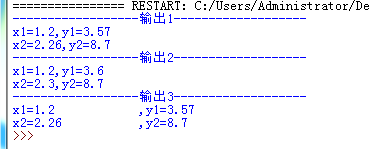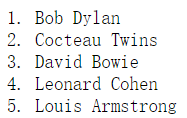实验2 字符串和列表
1. 实验任务1
x1,y1=1.2,3.57 x2,y2=2.26,8.7 print('{:-^40}'.format('输出1')) print('x1={},y1={}'.format(x1,y1)) print('x2={},y2={}'.format(x2,y2)) print('{:-^40}'.format('输出2')) print('x1={:.1f},y1={:.1f}'.format(x1,y1)) print('x2={:.1f},y2={:.1f}'.format(x2,y2)) print('{:-^40}'.format('输出3')) print('x1={:<15},y1={:<15}'.format(x1,y1)) print('x2={:<15},y2={:<15}'.format(x2,y2))
运行结果截图:

使用format()方法对输出数据项(小数)的格式控制用法:
1.{:-^40}控制输出数据格式: 宽度占40列,居中对齐,空白处用-补齐
2.{:.1f}控制小数输出精度,保留1位小数
3.{:<15}控制数据输出宽度占15列,左对齐,空白处默认补空格
2. 实验任务2
zifu=input('请输入一个字符串:') zifu=zifu.upper() zifu=zifu.replace('A','') print(zifu)
运行结果截图:

3. 实验任务3
name_list=['david bowie','louis armstrong','leonard cohen','bob dylan','cocteau twins'] n=1 for name in name_list: print(f'{n}:{name.title()}') n+=1
运行结果截图:

4. 实验任务4
name_list = ['david bowie','louis armstrong','leonard cohen','bob dylan','cocteau twins'] name_list.sort() n = 1 for name in name_list: print(f'{n}. {name.title()}') n += 1

5. 实验任务5
text = ("""The Zen of Python, by Tim Peters Beautiful is better than ugly. Explicit is better than implicit. Simple is better than complex. Complex is better than complicated. Flat is better than nested. Sparse is better than dense. Readability counts. Special cases aren't special enough to break the rules. Although practicality beats purity. Errors should never pass silently. Unless explicitly silenced. In the face of ambiguity, refuse the temptation to guess. There should be one-- and preferably only one --obvious way to do it. Although that way may not be obvious at first unless you're Dutch. Now is better than never. Although never is often better than *right* now. If the implementation is hard to explain, it's a bad idea. If the implementation is easy to explain, it may be a good idea. Namespaces are one honking great idea -- let's do more of those!""") print(len(text.splitlines())) print(len(text.split())) print(len(text)) print(text.count(" "))

6. 实验任务6
list = [] for a in range(3): x=input('输入想要加入愿望清单的事:') list.append(x) print('{:-^50}'.format('我的愿望清单')) for a in range(1,4): print(a,end='.') print(list[a-1])

实验总结
使用format()方法对输出数据项(小数)的格式控制用法:
1.{:-^40}控制输出数据格式: 宽度占40列,居中对齐,空白处用-补齐
2.{:.1f}控制小数输出精度,保留1位小数
3.{:<15}控制数据输出宽度占15列,左对齐,空白处默认补空格


